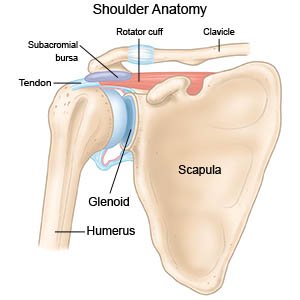Biceps Tenodesis
Medically reviewed by Drugs.com. Last updated on Apr 6, 2025.
What do I need to know about a biceps tenodesis?
Biceps tenodesis is surgery to repair a biceps tendon tear or to help make the tendon more stable. The biceps tendon will be detached from your shoulder socket. The damaged part of the tendon will be removed. Then the tendon will be attached to your upper arm bone (called the humerus). This helps relieve pain in your shoulder and make it more stable.
 |
How do I prepare for surgery?
- This surgery may be done as an open surgery or arthroscopically. During an open procedure, one large and several small incisions are made. During an arthroscopic procedure, several small incisions are made. An arthroscope is used to look inside your joint. Your surgeon will insert tools and the arthroscope into the incisions to work on the tendon. Your surgeon will talk to you about which kind of surgery is right for you.
- You may be given medicine to use to clean your skin. You will need to use it at home a few days before surgery and on the day of surgery. The medicine will come as a soap to shower with or cloths to wipe the area. Your healthcare provider will give you specific instructions if you need to use this medicine.
- Your surgeon will tell you how to prepare for surgery. You will be told not to eat or drink anything after midnight on the day of surgery. Your surgeon will tell you which medicines to take or not take on the day of surgery. Arrange for someone to drive you home after surgery and stay with you for at least 24 hours.
Drugs used to treat this and similar conditions
Aleve
Aleve is a nonsteroidal anti-inflammatory drug (NSAID) used to treat pain and inflammation. Learn ...
Naprosyn
Naprosyn (naproxen) is an anti-inflammatory drug used to treat pain and inflammation in arthritis ...
Omvoh
Omvoh is used to treat moderate to severe ulcerative colitis or Crohn's disease in adults. This ...
Myoflex
Myoflex is used for back pain, bursitis, muscle pain, osteoarthritis, pain, period pain, raynaud's ...
Naprelan
Naprelan is used for ankylosing spondylitis, aseptic necrosis, back pain, bursitis, chronic ...
Trolamine salicylate topical
Trolamine salicylate topical is used for back pain, bursitis, muscle pain, osteoarthritis, pain ...
Indomethacin
Indomethacin systemic is used for ankylosing spondylitis, back pain, bartter syndrome, bursitis ...
All Day Pain Relief
All Day Pain Relief is used for ankylosing spondylitis, aseptic necrosis, back pain, bursitis ...
Flanax Pain Reliever
Flanax (naproxen sodium) is used to treat minor aches and pains such as headache, backache or ...
EC-Naprosyn
EC-Naprosyn is used for ankylosing spondylitis, aseptic necrosis, back pain, bursitis, chronic ...
What will happen during surgery?
- You will be given medicine to keep you asleep and pain-free during surgery.
- The 2 main kinds of biceps tenodesis surgery are soft tissue and hardware fixation:
- For a soft tissue surgery, the tendon is moved into a groove made in the humerus. Your surgeon will detach the tendon, roll the end into a ball, and stitch it together. Then it is put into the groove made in the humerus and moved so it will stay in place.
- For a hardware fixation surgery, the tendon is moved into a hole your surgeon will make. A screw or other device will be used to fix the tendon to the bone.
What will happen after surgery?
Your arm will be put into a sling for up to 6 weeks to keep it from moving while you heal. Your healthcare providers will tell you if you need to sleep in the sling and when to wear it during the day. You may have a stiff or painful shoulder after surgery. This is normal and should get better with time and physical therapy. Your providers will tell you when to start having shoulder rehabilitation. These are exercises that will help increase your range of motion.
What are the risks of a biceps tenodesis?
You may develop an infection or bleed more than expected during surgery. You may also develop a hematoma (collection of blood) or a seroma (collection of fluid) under your skin. Nerves or veins may be injured or the humerus may be broken. You may have an allergic reaction to the fixation device. Any device used to fix the tendon to bone may fail. You may have chronic shoulder pain or stiffness, even after physical therapy.
Care Agreement
You have the right to help plan your care. Learn about your health condition and how it may be treated. Discuss treatment options with your healthcare providers to decide what care you want to receive. You always have the right to refuse treatment. The above information is an educational aid only. It is not intended as medical advice for individual conditions or treatments. Talk to your doctor, nurse or pharmacist before following any medical regimen to see if it is safe and effective for you.© Copyright Merative 2025 Information is for End User's use only and may not be sold, redistributed or otherwise used for commercial purposes.
Further information
Always consult your healthcare provider to ensure the information displayed on this page applies to your personal circumstances.
